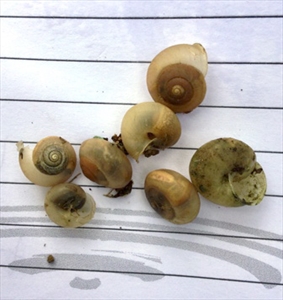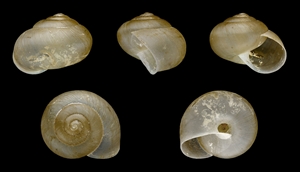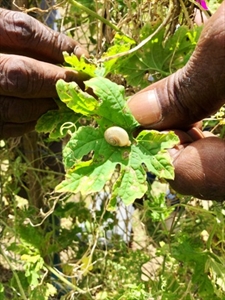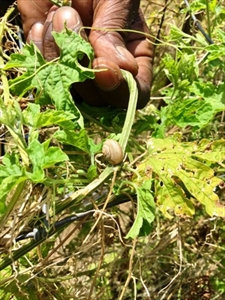Asian tramp snail
Pacific Pests, Pathogens, Weeds & Pesticides - Online edition
Pacific Pests, Pathogens, Weeds & Pesticides
Asian tramp snail (369)
Bradybaena similaris; previously, Helix similaris.
Asia, Africa, North and South America, Caribbean, Europe (restricted), Oceania. It is recorded from American Samoa, Australia, Cook Islands, Fiji, French Polynesia, Guam, Federated States of Micronesia, New Caledonia, Northern Marianas Islands, Samoa, and Vanuatu.
A large number of plants are hosts, vegetables, trees crops and ornamentals. Crops of economic importance include citrus, coffee, cucurbits, grapes, Hibiscus species, legumes, longan, and mango.
The snail is a serious pest in nurseries, vineyards, market gardens, and weed-infested bushland (in Australia). It is said to thrive in modified environments. Shells of the Asian tramp snail vary in colour from whitish to light brown (Photos 1&2). Each colour can have individuals with or without a narrow brown band where the whorls meet. The width of the shell is about 12-16 mm diameter, 9-11 mm tall, with 5.5 whorls that show fine growth lines (Photo 2). The mouth of the shell is slightly flared (curved outward) with white edges (Photo 2). There are types with the mouth to the right and others to the left.
The snail has both male and female sex organs, and is capable of self-fertilization. Eggs are laid just below the surface of moist soil; the numbers are variable between individuals but, on average, 30 eggs are laid over a lifetime. Eggs hatch in about 15 days, taking about 6 months to reach sexual maturity. Adults live for more than a year.
Spread of the snail occurs over short distances as it moves on the mucus produced by its 'foot'; over long distances it is spread by the international trade in plants.
The Asian tramp snail is a pest in many subtropical and tropical countries, especially on ornamentals. It is reported to be serious in Hong Kong on cabbages, watercress and beans. In Australia and Fiji, is it reported to be particularly important on cucurbits - melon and gourd (Photos 3&4). Southeast USA states consider that the snail is a threat to greenhouses, gardens and crops because of year-round high humidity, the snail's fondness for living plants and the absence of natural predators.
Note that when the snail occurs in large numbers on vegetables its faeces become a concern to human health. The snail is host to the rat lung worm.
Look for snails with shells about 15 mm diameter, whitish or light brown, some with outward curling white lip, with cream to light brown bodies and black tentacles.
QUARANTINE
The common name of the snail (Asian tramp snail) comes from it being found commonly on freight containers. Therefore, where it is not yet introduced biosecurity authorities should inspect carefully for its presence.
NATURAL ENEMIES
Predatory snails, such as Euglandina rosea and Gonaxis quadrilateralis, and flatworms, e.g., Platydemus manokwari, have been introduced into Pacific island countries to control invasive snails such as the Giant African snail, but the effects have been a disaster for local snail populations. Such introductions are to be discouraged outside the natural range of these predators. Environmental impact studies are essential before the introduction of these predators because of their non-specific nature.
Indian runner ducks will eat snails (and slugs); they are the only type of livestock that will do so. The fact that the snail is often aerial, within the foliage of climbing plants and trees, may limit the potential of ducks to manage them.
CULTURAL CONTROL
Cultural control is important. The following should be done:
- Make a strip of bare earth about 1.5 m wide around cultivated areas. Bands of sand are also effective.
- Collect the snail regularly; many factors determine the success of this method, not least the size of the area to be treated and the labour available.
- Set up 'beer traps'. Pour beer into a shallow pan. The beer attracts the snails and they fall in and drown.
CHEMICAL CONTROL
The usefulness of metaldehyde (pellets containing 1.5-1.8 % active ingredient) over large areas is not encouraged, it is a chemical toxic to livestock and human beings, as well as slugs. If used:
- Take care to prevent livestock, pets and children from eating the pellets.
- Poisoned snails should never be fed to pigs or other livestock.
- Put the pellets in tins or bamboos in the evening and collect them in the morning. Alternatively, scatter the baits sparsely in and around the plants to be protected so that pets and wildlife will not eat too much of the bait if found. It is best to water the site before applying the baits to stimulate snail activity and increase the chance that the baits will be eaten.
- Note, chemical control needs to be combined with cultural methods to be effective.
More recently, baits with iron-based poisons, e.g., iron phosphate and sodium ferric EDTA have been shown to be effective and safer to use. However, use to manufacturers' instructions.
Note, a ban on the outdoor use of metaldehyde will be introduced in the UK from March 2022. It can be used in permanent greenhouses. It poses an unacceptable risk to birds and mammals.
AUTHOR Grahame Jackson & Mani Mua
Information from Brodie G, Barker GM (2012) Bradybaena similaris (Rang, 1831). Family Bradybaenidae. Introduced land snails of the Fiji Islands. Fact Sheet Series, No. 2. USP, Fiji; and Bradybaenidae. Terrestrial Mollusc Tool. USDA, University of Florida. (http://idtools.org/id/mollusc/factsheet.php?name=Bradybaenidae); and Asian trampsnail. Wikipedia. (https://en.wikipedia.org/wiki/Asian_trampsnail); and from Capinera JL, White (2014) Featured Creatures: Terrestrial snails affecting plants in Florida. UF/IFAS, University of Florida. (http://entnemdept.ufl.edu/creatures/misc/gastro/terrestrial_snails.htm). Photo 1 Zell H Bradybaena similaris. (https://commons.wikimedia.org/wiki/File:Bradybaena_similaris_01.JPG).
Produced with support from the Australian Centre for International Agricultural Research under project HORT/2016/185: Responding to emerging pest and disease threats to horticulture in the Pacific islands, implemented by the University of Queensland and the Secretariat of the Pacific Community.







